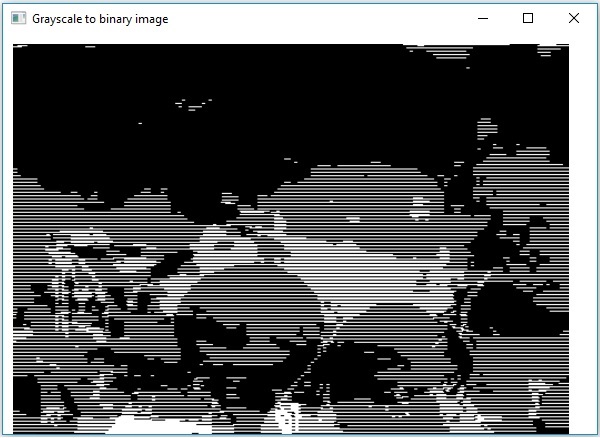📌 相关文章
- 灰度到二进制和二进制到灰度转换(1)
- 灰度到二进制和二进制到灰度转换
- 将图像转换为灰度 opencv - Python (1)
- OpenCV-以灰度读取图像
- 将图像转换为灰度 opencv - Python 代码示例
- Python|使用 OpenCV 对图像进行灰度化
- Python|使用 OpenCV 对图像进行灰度化(1)
- opencv 灰度转 rgb - Python 代码示例
- rgb 转灰度 python opencv - Python (1)
- OpenCV-彩色图像到灰度(1)
- OpenCV-彩色图像到灰度
- 在 python opencv 中检测灰度图像 - Python (1)
- rgb 转灰度 python opencv - Python 代码示例
- 在 python opencv 中检测灰度图像 - Python 代码示例
- 如何转换成灰度opencv - Python(1)
- Java DIP-OpenCV灰度转换(1)
- Java DIP-OpenCV灰度转换
- 灰度css(1)
- 如何转换成灰度opencv - Python代码示例
- 灰度转换
- 灰度转换
- 灰度转换(1)
- 灰度css代码示例
- 灰度 css 代码示例
- 灰度图像 (1)
- 在Python中使用 OpenCV 将彩色视频转换为灰度
- CSS |灰度()函数(1)
- CSS |灰度()函数
- 灰度图像 - 任何代码示例
📜 OpenCV-灰度到二进制
📅 最后修改于: 2020-11-23 03:38:41 🧑 作者: Mango
您可以使用上一章中提到的相同方法将灰度图像转换为二进制图像。只需将灰度图像的路径作为此程序的输入即可。
例
以下程序演示了如何将灰度图像读取为二进制图像并使用JavaFX窗口进行显示。
import java.awt.image.BufferedImage;
import org.opencv.core.Core;
import org.opencv.core.Mat;
import org.opencv.imgcodecs.Imgcodecs;
import org.opencv.imgproc.Imgproc;
import javafx.application.Application;
import javafx.embed.swing.SwingFXUtils;
import javafx.scene.Group;
import javafx.scene.Scene;
import javafx.scene.image.ImageView;
import javafx.scene.image.WritableImage;
import javafx.stage.Stage;
public class GrayScaleToBinary extends Application {
@Override
public void start(Stage stage) throws Exception {
WritableImage writableImage = loadAndConvert();
// Setting the image view
ImageView imageView = new ImageView(writableImage);
// Setting the position of the image
imageView.setX(10);
imageView.setY(10);
// Setting the fit height and width of the image view
imageView.setFitHeight(400);
imageView.setFitWidth(600);
// Setting the preserve ratio of the image view
imageView.setPreserveRatio(true);
// Creating a Group object
Group root = new Group(imageView);
// Creating a scene object
Scene scene = new Scene(root, 600, 400);
// Setting title to the Stage
stage.setTitle("Grayscale to binary image");
// Adding scene to the stage
stage.setScene(scene);
// Displaying the contents of the stage
stage.show();
}
public WritableImage loadAndConvert() throws Exception {
// Loading the OpenCV core library
System.loadLibrary( Core.NATIVE_LIBRARY_NAME );
// Instantiating the imagecodecs class
Imgcodecs imageCodecs = new Imgcodecs();
String input = "E:/OpenCV/chap7/grayscale.jpg";
// Reading the image
Mat src = imageCodecs.imread(input);
// Creating the destination matrix
Mat dst = new Mat();
// Converting to binary image...
Imgproc.threshold(src, dst, 200, 500, Imgproc.THRESH_BINARY);
// Extracting data from the transformed image (dst)
byte[] data1 = new byte[dst.rows() * dst.cols() * (int)(dst.elemSize())];
dst.get(0, 0, data1);
// Creating Buffered image using the data
BufferedImage bufImage = new BufferedImage(dst.cols(),dst.rows(),
BufferedImage.TYPE_BYTE_BINARY);
// Setting the data elements to the image
bufImage.getRaster().setDataElements(0, 0, dst.cols(), dst.rows(), data1);
// Creating a Writable image
WritableImage writableImage = SwingFXUtils.toFXImage(bufImage, null);
System.out.println("Converted to binary");
return writableImage;
}
public static void main(String args[]) throws Exception {
launch(args);
}
}
输入图像
假设以下是上述程序中指定的输入图像sample.jpg 。

输出图像
在执行程序时,您将获得以下输出。
